Traditional Māori Healing
In Māori Philosophy, MiriMiri is a vibrational exchange (Reo) between our Earth Mother (Papatuānuku) and the Goddess of the Sea (Hine Moana).
- "Mi" is a spacial vibration (nga reo e pa ana ki te rangi) between Sky Father (Ranginui) and Earth Mother (Papatuānuku).
- "Ri" is a divine celestial vibration (nga kupu tino tapu) considered sacred (tapu).
MiriMiri is preliminary to RomiRomi, which is deeper body work. Like the flow and ebb of the tide, MiriMiri can have alternating mutual tones of a gentle caress (haumiri) and an invigorating rhythmic dance (kanikani).
Likewise, RomiRomi means to stimulate and agitate internally -
- "Ro" is internal or inner, as with Ri, a divine celestial vibrational kupu (word)
- "Mi" is a spacial vibration between Ranginui and Papatuānuku who are Atua Māori (Supreme Beings)
hence the ability to flow between both the celestial (rangitūhāhā) or spiritual and earth realms.
Māori healing experts (Tohunga) utilised these practises to release energy that served no purpose to a person's physical (tinana), spiritual (wairua), mauri (life force) and psychological (hinengaro) wellbeing that they believed resulted from trauma, sickness, or extraneous reptilian energy trapped in the cellular memory.
Traditional Māori healers (Tohunga) used MiriMiri as a means of healing injuries, releasing old tensions, and balancing bodily function. It is thought that pain can be indicative of unresolved historic; past or current issues and not necessarily clinical. In conjunction with protective recitation (kaupare) and or ritual chant (takutaku) the practise of RomiRomi and MiriMiri is intuitive (uhumanea). Neutrality (remaining in whatumanawa) is maintained during the MiriMiri healing process to procure a state of calm, silencing conscious thoughts, aligning the individuals wairua and mauri (material symbol of a life principle).

Tohunga Suppression
In 1907 the Tohunga Suppression Act was passed as a "direct challenge to Māori healing practices by the scientific medical establishment" (Jones, 2000, p. 32). This Act prohibited Tohunga from claiming to possess any supernatural powers in the treatment or cure of any disease. As a result, Tohunga were driven underground and with them the practice of MiriMiri (Jones, 2000).
Practical Application of MiriMiri
A western definition for MiriMiri is the use of hands to physically manipulate the body's soft tissues for effecting a desirable change in the individual. In practise, MiriMiri is similar to Swedish Massage utilising a combination of strokes to manipulate the body tissues (tinana) such as petrissage and effleurage techniques (ropiropi /rubbing; paa / gliding; tapahi / hacking; kāuto / kneading; pīrori / rolling).
RomiRomi (deep tissue) encompasses trigger point (haemata) release utilising a combination of elbows, forearms, knuckles and in some cases feet, knees and pressure of practitioner's full body. Tools such as sticks (rākau) stones (pōhatu); native rongoa tree branches (rārā) are also incorporated in RomiRomi as well as manipulating the body's limbs (peke) to accommodate a range of movement to aid release and or to induce relaxation of muscles (uaua).
Neither MiriMiri or RomiRomi is carried out without first clearing the healing space (whakawātea) utilising blessed sea water (wai tai/wai tapu) and progressing with a kaupare or prayer.

Contraindications of MiriMiri / Massage
A contraindication is a situation when MiriMiri might not be performed. Continuing with treatment may be more detrimental than beneficial and in some cases, may cause further health problems. However other parts of the body where an injury or issue doesnot exist or is not affected indirectly, it is ok.
- Open wounds - Any cuts, lacerations or grazes. Wait until the scar has properly formed. This is usually between one and two weeks.
- Muscle and/or tendon ruptures - In the acute stage these may still be bleeding. MiriMiri not recommended till after the initial 48 to 72 hours, but it will depend on the extent of the injury.
- Muscle and tendon partial tears - MiriMiri may be suitable after a minimum period of 48 hours, longer for more serious injuries.
- Contusions - These are impact injuries causing bleeding within the muscle. MiriMiri too soon after the injury may cause further damage and may lead to Myositis Ossificans (bone growth within the muscle).
- Burns, Chilblains and Broken bones - MiriMiri will hurt obviously and cause damage in extreme cases.
- Periostitis - This is inflammation of the sheath that surrounds the bone. MiriMiri can be applied to the surrounding muscles but not the bone as it may cause irritation.
- Rheumatoid arthritis and gout - These are inflammatory conditions. The same rules apply here as to acute injuries. MiriMiri can be applied at your discretion, though caution, as may cause further inflammation.
- Bursitis - Inflammation to a bursa. A bursa is a small sack of fluid that helps tendons pass over bones at joints. If there is pain, swelling and redness over the skin then MiriMiri should be avoided.
- Myositis ossificans - A bad contusion or muscle rupture may begin to calcify (grow bone). MiriMiri not recommended.
- Infections of the skin and soft tissue - Bacterial infections, viral infections and fungal infections can be spread to other areas of the body, hence MiriMiri not a good idea.
- Thrombosis - This is a rare but potentially lethal blood clot in a vein. It is common in the calf muscle area. A deep, sore pain in the belly of the muscle may be a thrombosis. MiriMiri not recommended.
- Artificial blood vessels - Artificial blood vessels which are implanted through surgery should be avoided. No MiriMiri.
- Bleeding disorders such as hemophilia - MiriMiri may cause damage to tissues and result in bleeding.
- Tumors - Most often lumps are muscle spasms or fatty tissue and will be left well alone. Surrounding areas on the body (tinana) may still receive MiriMiri.
- Fever - When you have a fever, your body is trying to isolate and expel an invader of some kind. MiriMiri increases overall circulation and could therefore work against your body’s natural defenses.
- Inflammation - MiriMiri can further irritate an area of inflammation, so best to avoid. Inflamed conditions include anything that ends in “itis,” such as phlebitis (inflammation of a vein), dermatitis (inflammation of the skin), arthritis (inflammation of the joints), and so on. In the case of localized problems, you can still MiriMiri around them, however, avoiding the inflammation itself.
- High blood pressure - High blood pressure means excessive pressure against blood vessel walls. MiriMiri affects the blood vessels, and so people with high blood pressure or a heart condition should only receive light, sedating MiriMiri, if at all, with alternating short, slow(er) strokes to and from the heart (manawa).
- Infectious diseases - MiriMiri is not a good idea for someone coming down with the flu, for example, and the person providing the MiriMiri could expose themselves to the virus as well.
- Hernia - Hernias are protrusions of part of an organ (such as the intestines) through a muscular wall. MiriMiri is not a good idea. Surrounding areas ok being mindful of other possible health problems that may be affected indirectly.
- Osteoporosis - Older persons with a severe stoop to the shoulders often have this condition, in which bones become porous, brittle, and fragile. MiriMiri may be too intense for this condition. Otherwise keep it light and in a suitable position to receive MiriMiri comfortably.
- Varicose veins - MiriMiri directly over varicose veins can worsen the problem. However, if you apply a very light MiriMiri next to the problem, always in the direction of the heart, it can be very beneficial.
- Broken bones - MiriMiri not recommended. However, a little light MiriMiri to the surrounding areas can improve circulation and assist in repairing scar tissue.
- Skin problems - MiriMiri not recommended directly to anything that looks like it shouldn’t be there, such as rashes, wounds, bruises, burns, boils, and blisters, for example. Usually these problems are local, so you can still MiriMiri in other areas.
- Cancer - Cancers can spread through the lymphatic system, and because MiriMIri increases lymphatic circulation, it may potentially spread the cancer. Simple, caring light touch is fine, but MiriMiri strokes that stimulate circulation are not. MiriMiri received at your discretion.
- Other conditions - Diabetes, asthma, and other serious conditions each has its own precautions.
If in doubt, keep you and I safe, check with your Doctor first.
